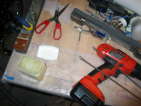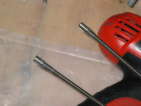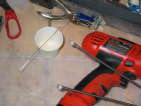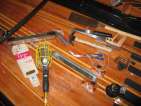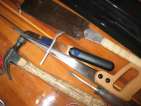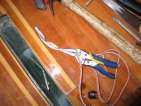Rigging the mast, centreboard inserts
posted 2007 November 26
Two main tasks this week: bonding the threaded inserts into the centreboard insert blocks, and drilling holes in the mast.
While bonding the threaded inserts in place, I wanted to make absolutely certain that the blocks didn't bond to the hull and that the rods didn't bond to the blocks. To do this, I rolled the ends of the rods in vaseline, then screwed them into the inserts, and put a dab of vaseline in the end of the insert. Then make sure that there is a think layer protecting the rod above the insert.
Next I mixed the epoxy and coated the interior of the holes in the block, and added some silica and coated the inserts, and then slid the rods through a carefully cut piece of plastic with holes cut the right distance apart to match the holes, and the holes cut slightly too small - so the plastic would be tight against the rods. Then slide the rods into the tubes, pop the threaded inserts/epoxy/silica into the holes in the trunk insert, push the block into place, push the tops of the rods to ensure they're deep in the holes, and let it cure. I decided to do only two at a time - I didn't want to have to deal with four of these at once (all going off in weird angles).
Set two went the same way: coat the inserts in vaseline and coat the insides of the holes on the trunk insert, coat the tips and insert them in the plastic, put them in the tubes and press the inserts into the block, and let everything cure. I didn't have much epoxy spreadout - there probably wasn't of the epoxy/silica which reached the bottom of the hole (it would have all been pushed off when I inserted it in the hole), but there was enough to hold the metal inserts in place, which is what counts.
Since I had a bit of excess epoxy from this, I also made a make a fibreglass tube for the 1/4” primaries bolt which goes through the mast. This is supposed to be 10-12mm when complete. I sanded down a thick drinking straw and wrapped it around that; the end of the straw helped twist the wet glass together, the system worked pretty well. Once cured, drill out the core.
For the drilling the holes in the mast part, I drilled two. The first was the hole for the t-ball insert. I drilled the hole, then reamed it out with the dremel. (This is - apparently - the right way to go about it - drilling the exact size hole isn't good, because the drill causes carbon on the inside of the mast to shred away.) To get the exact size, I used a rat-tail file to work my way up to the right size.
Once the hole was the correct side (the flares of the backing plate fit into it nicely), I slid a wire down the top of the mast and through the hole, slid the backing plate on, bent a loop in the end, and screwed a screw into the loop. Then pull it through the mast and pull the plate up flush against the back of the mast, while riveting it in place. To hold it tight while I riveted, I clamped the wire with a vice grip and held the vice grip against the mast. To get the the wire out, I pulled it tight and then snipped off the end, so the screw just fell out the bottom of the mast.
Next up was to cut the hole for the Holt-Allen HA15B sheave and install it. I did this in a manner similar to cutting the hole in the hull - measure where it should be (91 1/2” down), put the blue tape on so I knew not to go outside the lines. Drill a pilot hole, and follow with a bit of dremel work, and then file down the hole with a rat-tail file. The tendency is to cut these holes too large - and certainly it only takes a couple of swipes with the file to go from tight to loose... I wanted to ensure the fit was tight on the top edge so the rivet would have plenty of carbon to grip in, and I went from snug to very slightly loose (about 1/3 mm) in only a few strokes of the file.
Once the hole was ready, I had to file down the block itself; it was designed for a thinner mast wall, and I had to remove some of the flat. Once that was ready, rivet, and it's done.
| (19 images) | |||
|
